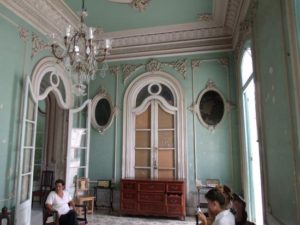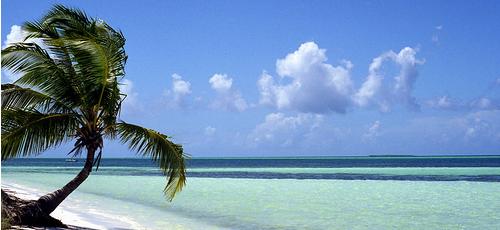Built in the city of Cienfuegos, in the center of Cuba, rich in monuments and symbolic buildings, is the Ferrer Palace for a century. For its viewpoint with dome from which you can enjoy the best view of the city and its marine environment, the property enjoys the privilege of its location, in a corner of Parque Martí, foundational and administrative center of the city.
The beautiful mansion, an example of the influence of “Catalanism” in Cuban architecture, was built between 1917 and 1918 by the wealthy merchant and Spanish landowner José Ferrer Sirés, under the project of the outstanding local architect Pablo Donato Carbonell, author of works of great Refinement and symbols of the eclecticism of that territory, such as the Villa de Valle, others of majestic structure such as the “Tomás Acea” cemetery, replica of the Parthenon.
José Ferrer Sirés, was a rich Catalan who lived in Cienfuegos and had put all the effort and part of his great fortune in the construction of the building. The work, which lasted only a year, was based on a design by the famous local architect Pablo Donato Carbonell, author of works such as Casa de Valle-a symbol of eclectic local elegance and the majestic cemetery Tomás Acea, a replica of the Parthenon.
The experienced designer put the artistic flavor of Catalan modernism in the two-story mansion. The first floor was intended for the storage of goods, that is why it is undressed and more than six meters high.
The second floor, on the other hand, shows a feast of marble, iron and glass ceramics, which, together with the high quality and good taste of the ornamentation, have given a characteristic elegance of this corner of the José Martí Park, founder and Administrative center of the city.
In the execution of the Palace, the outstanding designer put his artistic talent and this was formed on two levels: the ground floor, lacking in ornaments and high strut of more than 6 meters, destined to garnish goods, and a superior, whose splendor of ornamentation in Marbles, precious smithy, glazed tiles and exquisite decorations impressed him more.
The roof is topped by an elegant viewpoint in the southeast corner, which allowed the merchant from the heights to dominate all the operations of the nearby port and also witness the entrance to the bay of some possibility of increasing their economic coffers.
However, in spite of the inspiration and commitment of the designer in his desire to leave satisfied the refined taste of the Ferrer, the owners lived a short time the mansion moving to Havana, then very prosperous in the early 20’s, and the The estate was abandoned until the family of the Caicedos, one of the richest in Cienfuegos, bought it and lived until the late seventies of last century.
The majestic Ferrer Palace also gained a celebrity when the famous Italian tenor Enrico Caruso was in Cienfuegos in 1920 and stayed there one day to rest his voice in the spacious room, since he would sing that night at the nearby Teatro Tomas Terry.
It is said that he returned soon to Havana, where a final function awaited him before receiving the juicy sum of 90 thousand pesos, a record figure paid to an artist in the Cuban theater.
Unfortunately, Caruso did not have much time to enjoy the benefits of life as offered by the luxurious Palace, which was premiered in the architecture of the city, because after his commitments in Cuba, would only act once again in the Metropolitan, Of New York, before retiring forever from the scene because of an illness that ended with his life in 1921.
After a long period of deterioration of the place, works of restoration of the Palace Ferrer corresponding to the constructive actions of the Plan of Development by the bicentennial of the former Villa Fernandina de Jagua were undertaken, that will be fulfilled in April of 2019.
The mansion, once the Benjamín Duarte House of Culture inside the wonderful neoclassical building, offers from its terrace some of the best panoramic views of the whole city.
Agencies / Rad.Hab. / Guadeloupe Yaujar / Internet Photos / YouTube/ Arnoldo Varona / TheCubanHistory.com
THE CUBAN HISTORY, HOLLYWOOD.
FOLLOW US ON TWITTER AND FACEBOOK. THECUBANHISTORY.COM

EL PALACIO FERRER, UNA JOYA ARQUITECTÓNICA EN CIENFUEGOS. VIDEO.
Levantado en la ciudad de Cienfuegos, en el centro de Cuba, rica en monumentos y edificios simbólicos, se halla el Palacio Ferrer desde hace un siglo. Por su mirador con cúpula desde el que se puede disfrutar de la mejor vista de la ciudad y su entorno marino, el inmueble goza del privilegio de su ubicación, en una esquina del Parque Martí, centro fundacional y administrativo de la ciudad.
El bello palacete, ejemplo de la influencia del “catalanismo” en la arquitectura cubana, fue construido entre 1917 y 1918 por el rico comerciante y hacendado español José Ferrer Sirés, bajo el proyecto del destacado arquitecto local Pablo Donato Carbonell, autor de obras de gran refinamiento y símbolos del eclecticismo de ese territorio, como el Chalet de Valle, otras de majestuosa estructura como el cementerio “Tomás Acea”, réplica del Partenón.
José Ferrer Sirés, fue un rico catalán que vivió en Cienfuegos y había puesto todo el esfuerzo y parte de su gran fortuna en la construcción del edificio. El trabajo, que duró sólo un año, se basó en un diseño del famoso arquitecto local Pablo Donato Carbonell, autor de obras como la Casa de Valle-un símbolo de elegancia locales eclecticismo y el majestuoso cementerio Tomás Acea, una réplica de la Partenón.
El experimentado diseñador puso el sabor artístico del modernismo catalán en la mansión de dos pisos. El primer piso fue destinado para el almacenamiento de mercancías, es por eso que se desnuda de adornos y más de seis metros de alto.
El segundo piso, por el contrario, muestra una fiesta de la cerámica de mármol, hierro y cristal, que, junto con la alta calidad y buen gusto de la ornamentación, han dado una elegancia característica de este rincón del Parque José Martí, fundador y centro administrativo de la ciudad.
En la ejecución del Palacio puso el relevante proyectista su talento artístico y este quedó formado en dos niveles: la planta baja, carente de ornamentos y alto puntal superior a los 6 metros, destinado a guarecer mercancías, y uno superior, cuyo derroche de ornamentación en mármoles, valiosa herrería, azulejos esmaltados y primorosos decorados le imprimieron más prestancia.
Remata la azotea con un elegantísimo mirador en la esquina sureste, que permitía al mercader desde las alturas dominar todas las operaciones del cercano puerto y presenciar también la entrada a la bahía de alguna posibilidad de aumentar sus arcas económicas.
Sin embargo, a pesar de la inspiración y empeño del proyectista en su afán de dejar complacidos el refinado gusto de los Ferrer, los propietarios vivieron poco tiempo la mansión trasladándose a La Habana, entonces muy próspera a principios de la década del 20, y el inmueble quedó desierto hasta que la familia de los Caicedos, una de las más ricas de Cienfuegos, la compró y vivió hasta la década de loas años 70 del pasado siglo.
El majestuoso Palacio Ferrer ganó, además, celebridad cuando el famoso tenor italiano Enrico Caruso estuvo en Cienfuegos en 1920 y se hospedó allí un día a fin de descansar su voz en la espaciosa sala, ya que cantaría esa noche en el cercano teatro Tomás Terry.
Se dice que regresó pronto a La Habana donde le esperaba una última función antes de recibir la jugosa suma de 90 mil pesos, cifra récord pagada entonces a un artista en el teatro cubano.
Lamentablemente, Caruso no dispuso mucho tiempo para disfrutar de las bondades de la vida como las que ofrecía el lujoso Palacio, que se estrenaba en la arquitectura de la ciudad, pues luego de sus compromisos en Cuba, sólo actuaría una vez más en el Metropolitan, de New York, antes de retirarse para siempre de la escena a causa de una enfermedad que terminó con su vida en 1921.
Luego de un largo periodo de deterioro del lugar se emprendieron obras de restauración del Palacio Ferrer correspondientes a las acciones constructivas del Plan de Desarrollo por el bicentenario de la otrora Villa Fernandina de Jagua, que se cumplirá en abril de 2019.
La mansión, devenida la Casa de la Cultura Benjamín Duarte dentro del maravilloso edificio neoclásico, brinda desde su terraza unas de las mejores vistas panorámicas de toda la urbe.
Agencies/Rad.Hab./Guadalupe Yaujar/Internet Photos/ YouTube/ Arnoldo Varona/ TheCubanHistory.com
THE CUBAN HISTORY, HOLLYWOOD.







